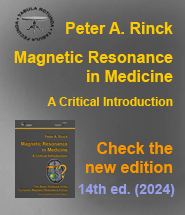Capítulo Veintiuno
Imaginería por RM: Datos y Figuras
21-01 ¿Cuál es la distribución por órganos de los estudios de RM?
 he spectrum of clinical MR examinations has hardly changed during the last decade. Brain and spine studies make up more than 50% of all studies, breast, heart and interventional studies less than 5%. fMRI (functional brain MRI) and other sophisticated examinations add up to less than 1% of all clinical MR studies.
he spectrum of clinical MR examinations has hardly changed during the last decade. Brain and spine studies make up more than 50% of all studies, breast, heart and interventional studies less than 5%. fMRI (functional brain MRI) and other sophisticated examinations add up to less than 1% of all clinical MR studies.
 |
|
Figure 21-01: |
Notes:
• Relative distribution of MR examinations by organ or applications given in Figure 21-01: The percentage will only slightly change in the future. However, the absolute number of examinations will drastically increase – not necessarily for medical reasons, though.
• For the "Facts and Figures" section we try to collect data through our own channels. The numbers published by OECD (Organization of Economic Cooperation and Development) and WHO (World Health Organization) are not absolutely dependable, but the best collected data available from international organizations. In many instances, OECD data do not contain the number of units in freestanding imaging facilities nor those of state or military owned facilities. In many countries even the responsible state administrations (ministries of health) cannot provide reliable numbers, nor can the manufacturers of MR equipment and those of accessories. For some countries, the number given here may substantially differ from those distributed by OECD and WHO. They were collected from insurance or reimbursement companies or private sources.
![]()
 Facts and figures = frustration and falsehoods.
Facts and figures = frustration and falsehoods.
The years change – the problem remains.
A comment.
![]()
21-02 ¿Cuántas máquinas de RM hay?
In the early 1980s, there were 12 machines, and everybody working with MR imaging knew each other. Then it went like this (Figure 21-02).
Today, we can just give an impression of magnitudes, a general trend. Worldwide, there are approximately 36,000 MR machines. At present, about 2,500 MR imaging units are sold worldwide every year. Usually, after an average of seven years, many machines are being replaced or refitted. Therefore the overall number of machines sold does not represent the number of machines in use.
 |
Figure 21-02:
Worldwide sales of MR machines by field strength per year between 1982/3 and 2001.
(EMRF|TRTF counts).
The biggest markets are still the United States of America with some 45% of worldwide sales, followed by Europe which buying approximately one quarter of all units, and Japan with 15%.
Japan has the highest per capita number of MRI units, followed by the U.S.A.. The Chinese market is huge and moving, but even approximate data are difficult to get. Data for major countries with liberal and uncontrolled health systems such as the U.S.A. fluctuate widely. Those with state controlled or supervised health systems such as Canada or France know exactly (or "more or less") how many MR machines are operating, and try to keep the "business side" of MR operators under control.
In addition, there are approximately 80 hybrid PET-MRI systems worldwide.
Ten to fifteen machines per one million inhabitants fully satisfy the medical needs of the population to date. Table 21-01 gives an overview of the number of MR units in some exemplary countries worldwide.

|
Table 21-01:
Overall number of MR machines in some selected countries (EMRF estimates, 2016).
In countries with (over-) saturated markets, e.g., the U.S.A., Japan, Korea, Switzerland, and Germany, there is a high risk of overuse of MR imaging. According to the OECD [⇒ OECD], between 1997 and 2006, the number of examinations in the U.S.A. has increased dramatically while the occurance of illnesses have remained constant. Furthermore, where payment incentives allow companies and physicians to benefit from referrals, the likelyhood of overuse increased.
21-03 ¿En qué intensidades de campo trabajan?
The choice of an MR system might be quite agonizing. Field strength is one, but not the only and most important, parameter; higher field strength does not guarantee a better quality system or better diagnostic outcome for the patient. Since there are no scientifically reliable outcome studies, any claims about superiority of equipment types or best field strength must be looked at cum grano salis.
Needs must be carefully assessed in the choice of an MR imager. The quality of the component parts, both in terms of hardware and software, makes a considerable impact. Service, maintenance, and knowledge of how to run the system are of pivotal importance for image quality and assessment.
There is no optimum field strength for MR imaging (see Table 03-04 for a comparison between 1.5 T and 3.0 T). Certain MR-based techniques such as functional imaging need high fields, clinical MR imaging doesn't. The diverse nature of applications requires different systems operating at an appropriate field; there is no single perfect or ideal field strength for all clinical indications and/or research questions. Image contrast does not necessarily increase with field strength (see Figure 10-15).
Ultralow equipment (≤ 0.1 T) is hardly used any more, most clinical machines operate at medium and high fields. At present, there is a trend towards ultrahigh research machines, operating between 3 T and 11 T (Table 21-02 and Figure 21- 03) aimed at research and commercially competitive sites. At present, there is no proof that such units are of better clinical value than medium or high field machines although there are numerous claims of better "patient outcome". Manufacturers try to push them into the clinical market, although it is unlikely that they will be used in clinical settings because of their side effects.
MR systems are available in the well-known tunnel shape or as open systems. The latter reduce patient claustrophobia and are better suited for interventional purposes because there is access to the patient from all sides. Open systems are available between 0.3 T with permanent magnets to 1.5 T with superconducting magnets.
 |
|
Table 21-02: |
 |
|
Figure 21-03: |
In the United States, there are approximately 11,500 MRI systems. Between 60% and 75% operate at 1.5; less than 25% below 1.5 Tesla, less than 10% at 3.0 Tesla (rounding error). One quarter of all systems in the United States are open, the rest conventional closed systems. In general, markets differ in their local demands. Open systems are mostly sold in the United States, the market share of open system is limited in Europe and Japan. Three-Tesla (and higher) wholebody systems are fashionable, but of limited importance in sales and diagnostic relevance.
Depending on the market, the lowest quoted price of a new 1.5-Tesla state-of-the-art clinical MR imager can be below € 600,000 (~US$ 650,000); low and medium field units can be found in the same price range. Ultrahigh field equipment is substantially more expensive, as are machines with options such as functional imaging or spectroscopy. Service and maintenance are expensive.
![]()

Murphy's Law is the most reliable guideline:
How to buy an MR machine.












